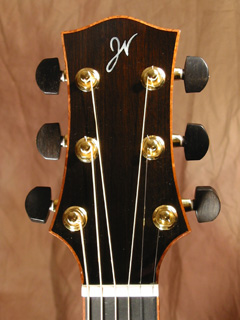Three new threads in a day, eh? Anyway...
I'm doing one of my periodic 'inventory reshuffles' (ie, going through the stuff I have, checking there's no weird humidity/damage/whatever going on, and mostly just an excuse to play with the pretty tonewood), and I'm just sorting through my 15-odd oversized madagascar rosewood bridge blanks. These are all plenty large enough for two bridges (14-1/4" x 2" x 9/16". They're consistently sized, within about 1/8", 1/16", mostly width variation if any. They're also very pretty. And ring very much like bells. So I set about tapping 'em, and I notice the wide variety of notes I get out of them.
All are musical, clear (holding the piece lightly between thumb and middle finger at about 1/4 of its lenght) tones, but the tap tones are dinstinctly different. I don't have a scale, or I'd weigh them, but the lighter pieces seem to have a lower frequency tone than the heavier ones (the difference between the highest pitch and the lowest is 6 half-stems: highest pitch is an E, octave on 1st string, lowest is a B.). Out of the 15, 2 each are at the extremes (high and low pitch), 2 and 1 one step in from each extreme, then 5 and 3 (lower half/upper half). Slightly left-leaning normal distribution. There seems to be little to no correlation between colour and tone; all of the lowest tap tone pieces are dark and ink-lined, and the incidence of lighter coloured pieces does increase as the tap tone gets higher, but there are chunks just as dark coloured in the 'upper register'. It's also mildly entertaining that the frequencies match very, very closely. Many match exactly (might've been the same board/tree, although intra-group variability is still high), some are off by a few cents (I guess due to size differentials).
I have no clue what this means, or which ones will make better bridges, or even which bridges to use in what situation, but it's still fun stuff. But I am tempted to label 'em by tap tone now, rather than merely based on aesthetics (more ink = pretty).
Thought I'd share that impressively trivial revelation :-)
|
